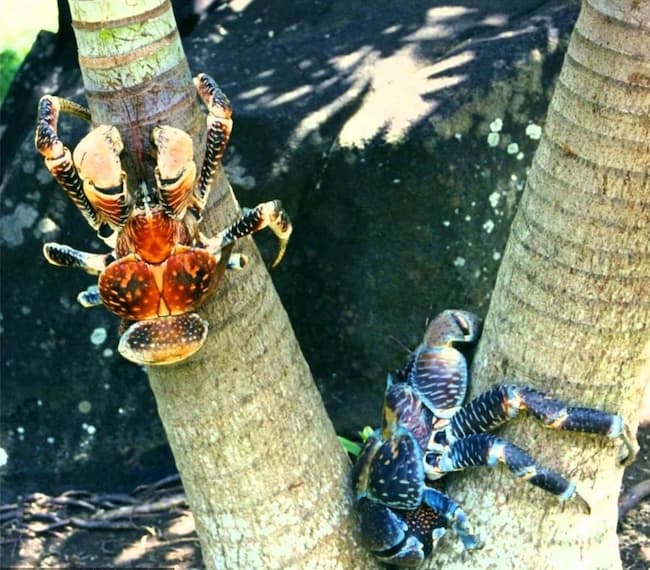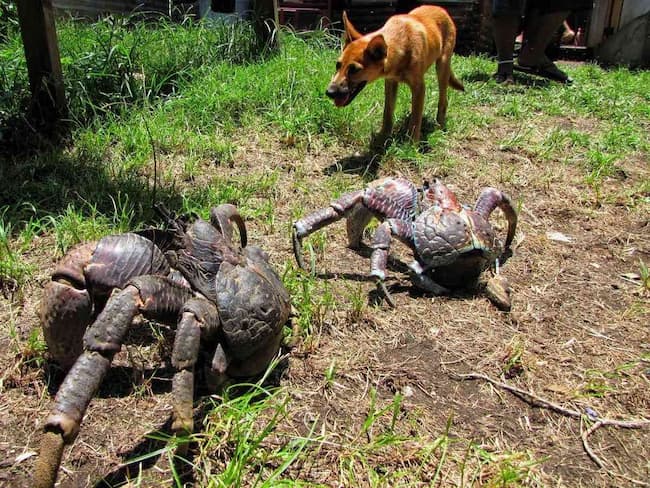In the realm of extraordinary creatures, few can match the intrigue and fascination inspired by coconut crabs. These colossal land-dwelling crabs, renowned as the largest of their kind globally, boast impressive weights exceeding 4 kg (8.8 lbs) and lengths nearing a meter (3 feet). Join us on a captivating journey as we unravel the mysteries of coconut crabs, creatures that blur the lines between the land and the sea.

Picture a creature that bridges the terrestrial and marine worlds—the coconut crab. Despite its name, these giants aren’t preying on coconuts but are instead famed for their colossal size and unique adaptations. From their formidable claws to their intricate exoskeletons, coconut crabs are a marvel of nature.
Let’s dive into the sheer enormity of these crustacean titans. With weights surpassing 4 kg, coconut crabs defy the expectations of what we typically associate with crabs. Their formidable size not only sets them apart in the crab kingdom but also earns them a place among the largest land-dwelling arthropods globally.

Unlike their marine relatives, coconut crabs have adapted to a terrestrial lifestyle. They inhabit tropical islands, showcasing their versatility by navigating both land and sea. From sandy shores to lush forests, coconut crabs embark on a land odyssey, foraging for food and seeking shelter in the nooks and crannies of their island habitats.

While coconut crabs are masters of the land, their life journey begins in the sea. The larvae, released by females into the ocean, undergo a transformative journey before returning to the land as miniature versions of the colossal creatures they’re destined to become. This cycle, an intricate dance between sea and land, adds another layer of fascination to the coconut crab narrative.
Contrary to popular belief, coconut crabs don’t solely feast on coconuts. Their diet is surprisingly diverse, ranging from fruits and nuts to carrion and smaller creatures. Their powerful claws and adaptability make them efficient scavengers and opportunistic hunters, contributing to their survival in the diverse ecosystems they inhabit.

As we marvel at the wonders of coconut crabs, it’s crucial to address conservation concerns. Human activities, habitat loss, and climate change pose threats to these remarkable creatures. Conservation efforts are essential to ensure the preservation of coconut crabs and the delicate ecosystems they call home.
In conclusion, coconut crabs stand as nature’s masterpieces, defying expectations with their colossal size and captivating life cycle. Their ability to navigate both land and sea showcases the resilience and adaptability of these remarkable creatures. As we delve into the mysteries of coconut crabs, let us not only appreciate their uniqueness but also advocate for their conservation, ensuring that these giants of the land continue to grace our tropical shores.
Frequently Asked Questions:
1. How large can coconut crabs grow? Coconut crabs can weigh more than 4 kg (8.8 lbs) and reach lengths of nearly a meter (3 feet), making them the largest land-dwelling crabs globally.
2. Why are they called coconut crabs? Despite the name, coconut crabs are not exclusive coconut predators. The name likely stems from their ability to climb coconut palms and feed on fallen coconuts.
3. Where do coconut crabs live? Coconut crabs inhabit tropical islands, showcasing their adaptability by navigating both land and sea. They can be found in diverse habitats, from sandy shores to lush forests.
4. What is the life cycle of a coconut crab? The life cycle of a coconut crab begins in the sea, where larvae undergo a transformative journey before returning to the land as miniature versions of the colossal creatures they become.
5. Are coconut crabs endangered? Conservation concerns surround coconut crabs due to human activities, habitat loss, and climate change. Conservation efforts are crucial to protect these giants of the islands and their unique ecosystems.

